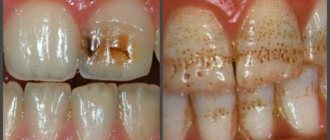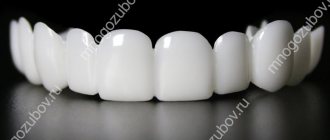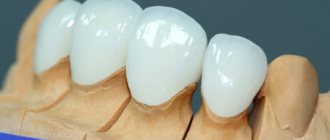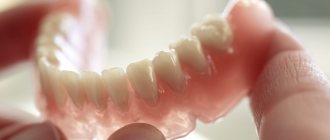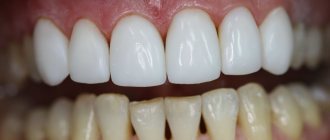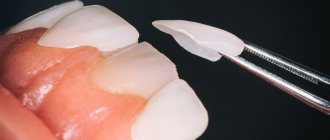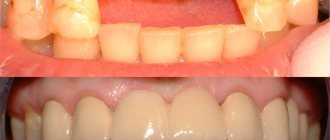Dental problems occur not only among the older generation, but also among healthy young people.
This is due to a spoiled environment, poor nutrition, bad habits or congenital diseases and defects in the anatomical structure or location of teeth in a person’s mouth. One of the best ways to correct defects in teeth along the smile line and create external aesthetics is to install veneers. On the Internet and in the media you will find information on how to easily get rid of aesthetic problems with teeth using these composite or ceramic dental onlays.
Veneer manufacturers promise consumers excellent results for many years, but is this really true? To answer this question, specialists from the LeaderStom network of dental clinics studied and analyzed reviews from patients who are actual owners of veneers on their teeth.
Porcelain veneers
Porcelain plates are visually indistinguishable from the enamel of a normal tooth. Therefore, ordinary people will never guess about the installed records.
The advantages of ceramic crowns are that they are resistant to stress and practically do not stain.
Porcelain microprostheses are made using two methods:
1. Pressed ceramics - the material is applied in layers, then each layer is fired. In this case, the teeth are not ground down.
2. Pressed material – ceramic material is pressed under pressure and then fired at high temperatures. This method is used to achieve the strongest possible structure.
How to make porcelain veneers is decided by the doctor, based on the individual characteristics of the patient.
Plus, the service life of ceramic restorations is more than 20 years. If you decide to put veneers or crowns on your teeth, follow hygiene procedures.
Reviews
Although microprostheses made of composite are inferior in quality and strength to ceramic ones, they have many positive reviews. Most patients note their affordable cost, quick production and, when high-quality modern composites are used, their good aesthetics and safety.
You can share your impressions about the use of composite overlays and your opinion about their effectiveness by leaving a comment on this article.
If you find an error, please select a piece of text and press Ctrl+Enter.
E-max ceramic veneers and zirconium dioxide
Metal-free veneers contain a frame made of lithium disilicate or zirconium dioxide. Such plates are almost transparent and have a fine structure. And unlike others, their service life increases to 25–30 years.
Pros of ceramic zirconium veneers
• Duration of operation is longer than that of porcelain;
• Lithium disilicate plates look natural, regardless of lighting;
• Color does not change after eating food coloring;
• Do not accumulate plaque if the rules of oral hygiene are ignored;
• Does not have a black coating when smoking;
• They are light in weight and thin, so wear off of the enamel is minimal.
Zirconium veneers, unlike composite plates, are placed on teeth, even in the most difficult clinical cases. Usually, they are inserted in the smile zone - on the 10 upper and 8 lower teeth.
The downside is that the insertion process takes longer due to the fact that the material is difficult to fix on the tooth surface.
Installation requires minor tooth grinding.
Advantages
The popularity of using composite plates for dental restoration is due to a large number of advantages:
- installation can be carried out with a minimum grinding area, or without grinding the tooth at all;
- in case of poor-quality restoration, the composite can be removed without damaging the surface;
- the procedure for manufacturing and installing this type of onlay takes much less time than a similar procedure with ceramic veneers;
- the use of composite material gives the surface a natural color and shape;
- low cost.
Composite veneers (componeers)
They are made from filling material in two ways and differ in how veneers are placed on the teeth:
1. Aesthetic filling (therapeutic) - installation occurs in one stage. Specialist. Using equipment, the doctor polishes the front side of the tooth. Then filling material is applied to this plane. Apply as thin a layer as possible. This method can hide only minor aesthetic problems.
2. Production of composite plates in a dental laboratory using special impressions. Before installing veneers on the front teeth, the dentist grinds down the enamel. The process requires several steps, so the implants are fixed at subsequent appointments.
The downside is that the service life of composite veneers is 5 years. A significant disadvantage is also a change in the color of the plates - darkening of the cladding.
Minuses
Among the numerous reviews about composite veneers, you can come across some in which patients indicate the following disadvantages:
- Only minor defects can be corrected;
- require periodic polishing;
- darken over time;
- quickly stained by drinks and foods containing dyes;
- short service life: on average no more than 5 years;
- they are inferior to ceramic products in terms of durability and aesthetics;
- quickly erased;
- the surface cannot be polished to a shine;
- there is a high probability of surface defects;
- It is not always possible to choose the required shade of the lining, since their color palette is limited.
Many characteristics of composite plates are directly related to the doctor’s approach to work: his qualifications and experience. A well-made overlay will reveal the shortcomings of the material to a lesser extent.
Indications for installation of veneers
1. People who were unable to achieve the desired teeth color.
2. Darkening of the tooth enamel occurred due to a filling made with formaldehyde paste, or when a nerve was removed.
3. Old fillings that have changed their color and differ from tooth enamel.
4. They are given to people who have diastemas, trema, and chips.
5. When the teeth have an irregular anatomical shape (wedge-shaped).
6. The patient has diseases - this could be enamel erosion, necrosis, hypoplasia, etc.
Rules for the use and care of composites
If you want to maintain the aesthetics of your front teeth at a decent level, then be sure to take care of composite veneers and follow certain rules for their use:
- watch what you eat: limit the consumption of foods containing bright coloring pigments. Unfortunately, the pigment accumulates in the pores of the composite, and it is not possible to remove it from there.
- stop smoking: tobacco smoke will not only change the color of the restoration, but will also contribute to the destruction of the artificial material, which will reduce the service life of the onlays to 1.5-2 years,
- Do not put the pads to the test of strength: do not bite your nails, pencils, seeds, do not bite threads, do not open bottles. Cut fruits and vegetables into pieces before eating.
- visit the dentist once every six months to identify diseases, check the integrity of the onlays and polish them,
- Do not brush your teeth with a hard-bristled brush and whitening paste: this will lead to the appearance of microcracks and grooves in the material.
Who are veneers contraindicated for?
People who have the following diseases and problems are not recommended to get implants.
• The presence of a dental anomaly “bruxism” is a forceful clenching of the jaws during sleep.
• Insufficient amount of tooth enamel.
• Bite pathology, meaning straight, deep bite.
• Caries and its complications.
• A group of diseases that are characterized by inflammatory processes - gingivitis, periodontal disease, etc. These diseases are a temporary contraindication. After treatment, the structures are successfully installed.
• Severe tooth fragility, or the presence of a bulky filling.
Contraindications
Many years of dental practice in installing composite microprostheses have allowed specialists to compile a detailed list of contraindications for this procedure. It is not recommended to install them in the following cases:
- incorrect occlusion;
- addiction to habits that harm teeth: opening bottles and caps with them, the habit of constantly biting nails, pencils, cracking seeds;
- engaging in hazardous sports;
- pathological abrasion and thinning of enamel;
- bruxism;
- severe damage, loosening, weakening, curvature of teeth, as well as short units;
- acute diseases of the gums and teeth;
- insufficient enamel thickness;
- nerve removal;
- recently carried out intensive fluoridation;
- lack of chewing units;
- failure to comply with hygiene rules.
Dentists do not recommend placing onlays on milk units.
Some of these contraindications are relative. Once they are eliminated, the patient will be able to install veneers without any problems.
Veneers and Lumineers, and how they differ
Lumineers are crowns made from special dental porcelain.
Lumineers are produced by the American company, which has developed and patented the specific composition of dental porcelain and production technology. This company produces lumineers in California. Therefore, the production of such micro prostheses takes about 30 days.
The word lumineers comes from the Latin word “lumen”, which literally means “light”. The creators of lumineers claim that your teeth will become much whiter. This means that the client will receive a “Hollywood smile”. However, veneers are not much inferior to lumineers. The latter can be distinguished rather by their “luminous effect”, but otherwise they are simply an analogue of ceramic veneers.
A significant advantage of lumineers is the thickness of the plate. It is: 0.2 - 0.3 mm, and the thickness of the veneers: from 0.2 mm. up to 0.8 mm., therefore, lumineers are installed without preliminary turning, just like veneers. The impression is made directly from the tooth.
Preparatory process
1. Hygienic teeth cleaning, plaque removal.
2. Grind down a thin layer of enamel, from 0.5 to 0.7 mm.
3. A harmonious shade is selected.
4. The remaining enamel is coated with a special acid.
5. An impression is made.
6. The tooth plate is carefully polished and onlays are inserted.
A thin layer of enamel is ground off in order to achieve the most harmonious and natural look. They also grind it in order to insert and firmly strengthen the plate.
The process of installing permanent veneers
Permanent microprostheses are placed at the second appointment. First, the orthopedist visually assesses how suitable the finished model is:
- According to the form;
— By color;
- According to the tightness of fit to the surface of the tooth.
When the dentist is convinced that the characteristics are correct, the onlays are installed.
1. The finished structure is fitted.
2. Then they control the accuracy and tightness of the fit.
3. The procedure is completed with fixation of microprostheses.
Is it possible to get veneers without grinding teeth?
In order to avoid grinding down the enamel, veneers made from feldspar and E-max should be inserted; they are thinner and do not require such a procedure.
It is possible to refuse turning if:
1. You have uneven teeth;
2. If the teeth are heavily worn;
3. It is necessary to change the direction of a crooked tooth;
4. It is necessary to add volume to the tooth.
There are no ideal teeth, so veneers without grinding cannot yet be placed. Except if the teeth are sparse and not voluminous. Grinded teeth can no longer be restored in the future, so you will always need to install crowns or their equivalents.
What happens to the teeth under the structure?
When the stitching is carried out correctly, and the design of the micro prosthesis is installed correctly, then nothing happens. However, if a plate, for example a composite, is not fixed tightly, caries or plaque accumulation may appear in such areas.
In case of plate defects, it is necessary to restore the micro prosthesis.
The downside is that it is impossible to remove the veneers; only the structure is replaced.
Most dentists provide a one-year warranty after installing the onlays.
pros
Compared to other methods of restoring damaged teeth, composite products have several significant advantages:
- Low cost : an inexpensive composite allows you to make an overlay without the use of expensive complex technologies.
- Short procedure time : installation usually takes place in one visit to a specialist. To restore a tooth, he does not need to take an impression and wait for a microprosthesis to be made from it in the laboratory; he does not need to try them on and adjust them.
- Rapid improvement in the aesthetics of the frontal units : in the absence of contraindications, the entire restoration process takes about an hour.
- Good aesthetics : the composite matches the hard dental tissues in shade and structure, has color stability and does a good job of imitating its own chewing elements. Thanks to this, there is no need to restore all teeth; it is enough to only restore damaged ones.
- Maximum preservation of native units : minimal preparation of hard tissue is performed before placing onlays.
- Good preservation of products: the quality of their surface does not change with proper care and use. The material is completely indifferent to the surrounding tissues.
- Restoration with composite material is reversible : if necessary, the dentist very quickly removes the composite from the enamel.
- Comfortable operation : according to patient reviews, the material does not cause discomfort, negative emotions, inconvenience, or the sensation of a “false jaw.”
We will talk about ceramic dental crowns, their advantages and disadvantages. In this review we will tell you which prostheses are best to install.
